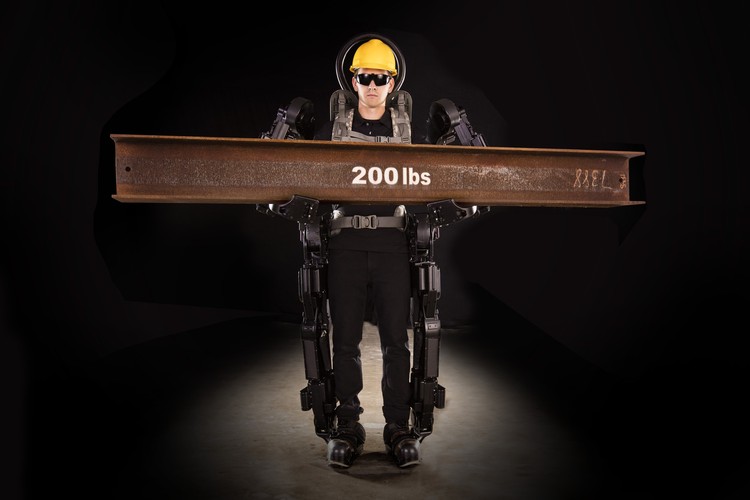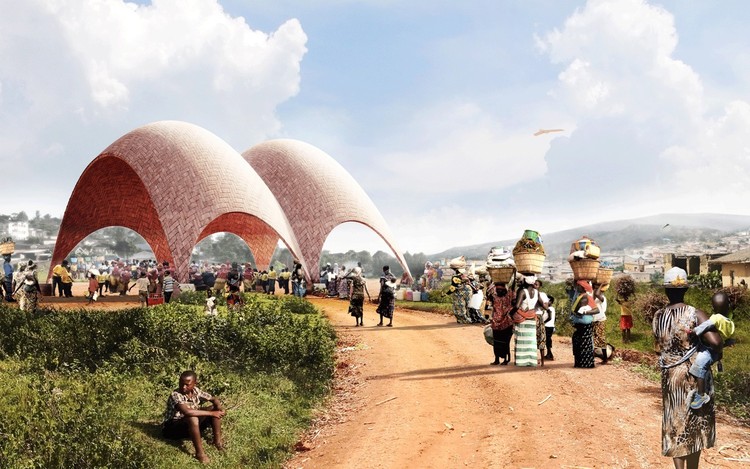
The construction industry has evolved throughout time, but always by way of builders. What happens when people are no longer part of building and construction? This is the question asked by British multinational infrastructure company Balfour Beatty, and they’ve published their answer in the 2050 Innovation Paper. The industry report has become a reference point to those looking at the evolution of buildings and design.

Balfour Beatty’s report brings a series of conclusions: robots will work in teams to build complex structures using dynamic new materials, while elements of a build will self-assemble. Drones flying overhead will scan the site, inspecting the work and using the data collected to predict and solve problems before they arise, sending instructions to robotic cranes and diggers and automated builders with no need for human involvement. The result is a human-free construction process, one where the role of the builder moves to “overseer” and they are remotely managing projects. If people are still on site before being phased out, they will be using robotically enhanced exoskeletons and neural-control technology to move and control machinery and other robots on site. These movements could eventually address the dangers of construction and make Zero Harm a reality.
It may seem like a sci-fi future, but the future is already underway. Advances in construction are happening in months rather than after years of development, with technologies helping to coordinate repetitive and laborious tasks through systems like Building Information Modelling (BIM), drone construction, VR/AR, 3D printing and wearable technology. At the same time, we continue to find better ways to promote health, safety and productivity on the construction site. A study by the Midwest Economic Policy Institute (MEPI) estimates that by 2057 robots could replace or displace 2.7 million jobs in construction. Global consulting firm Roland Berger found that less than 6% of construction companies make full use of digital planning tools, and 93% of construction industry professionals agree that digitization will affect every process. But what does this mean for design?

Beyond the trends and reports, there are deeper ideological changes that come with human-free building. In terms of design and an appreciation for craft, we may begin to lose a “human touch” and the haptic qualities of construction. It is directly tied to the very meaning of tectonics; the science and art of construction, the activity of building, and the resulting details and connections. This “art” would become robotic, completed by drones and 3d printers, and our relationship to materials, scale, and details changes, whether we find beauty in this process or not. It may also lead to new spaces and forms. As digitization brings an increase in productivity to a historically low-productivity sector, the relationships between builder and architect will change.
Balfour Beatty goes on to paint a picture of what’s to come: “the Internet of Things will power smart buildings with new, self-healing, energy generating or breathable materials, in smart cities which are able to model the future and adapt instantly to changing circumstances; construction will get faster, and we’ll see the advent of 3D printing of bespoke components and entire buildings, with 4D printing where self-transforming objects respond to changes in heat, sound or moisture levels to change shape.” At the same time, advances mean new jobs and industries will be created. These will provide new opportunities to the traditional “builder” as we move closer to human-free construction.
New modes of construction will change practice. They will also bring new answers to skill shortages, customer delivery, profitability and sustainability. Architects will need to place these advances and changes in context and answer for themselves where they derive meaning as the pace of digital change is only set to increase. As designers grapple with these questions, we’ve brought together a range of articles looking at the future of human-free construction on ArchDaily.
How Drones Can Be Used in Architecture

Small unmanned aerial vehicles (UAVs), commonly called drones, are gaining in popularity not only among the general public and consumers, but also among professionals working in the AEC industry. We’ve seen ambitious predictions for the use of drones on construction sites, as transportation vehicles and marketing tools. While this new technology, like 3D printing and robotic fabrication in general, promises to revolutionize the architectural profession, it is useful to know to what extent its practical application can affect the way archipreneurs work. It seems that, for now, drones have great potentials when it comes to several aspects of the profession.
Bionic Construction Workers Coming in 2020

American robotics company Sarcos has revealed a new full-body exoskeleton for construction workers that aims to be commercially available in 2020. While the US manufacturer specializes in military and public safety devices, the new robotic exoskeleton allows workers to carry up to 200 pounds for extended periods of time. Called the Guardian XO, the design has been in development for nearly two decades and is made to help reduce strain on construction workers.
The Golden Age of 3D Printing

3D printing itself is no longer a new technology, but that hasn’t stopped researchers and innovators around the world from coming up with new applications and opportunities. Some experiments with new materials have been driven by sustainability concerns and others are simply the result of imagination and creativity. Others have chosen to invest their time utilizing more traditional materials in new ways. Materials, however, are just the beginning. Researchers have developed new processes that allow the creation of objects that were previously impossible to print and, on a larger scale, new building typologies are being tested - including a Mars habitat!
Could 3D Printing be the Future of Social Housing?

This is all quite recent: less than a year ago, a French family became the first in the world to live in a 3D printed house. Short of 20 years, this seemed like a distant dream, this new technology has developed quickly, and it arises as a possible contribution to the housing crisis around the world. The Chinese company WinSun was the first to build a 3D printed house, and in 2013 it was able to print 10 houses in a period of 24 hours. These homes required human assemblage, given that their walls were printed at a plant to be transported to the respective sites.
Droneports in East Africa and the Global South

A new video by AERIAL FUTURES explores the potential of droneports in East Africa and the Global South. The Norman Foster Foundation was one of the first groups to propose the creation of a droneport network to deliver medical supplies and other necessities to areas of Africa that are difficult to access due to a lack of roads or other infrastructure. The project aspires to have droneports across small towns in Africa and in other emerging economies by 2030.





